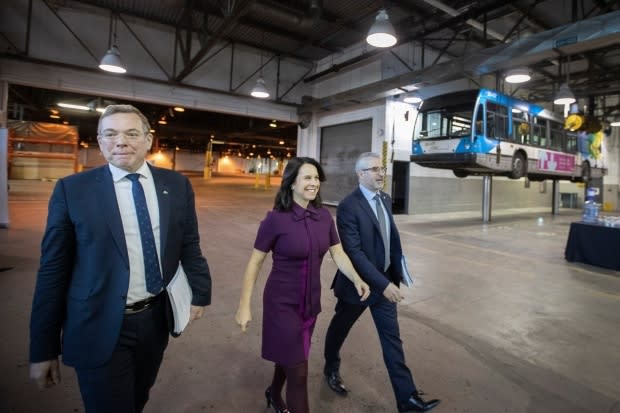STM promises relief for jam-packed Metro lines, sidelined buses
The STM is expanding on its commitment to run a train every five minutes, at minimum, on both the Metro's Orange and Green line.
The public transit agency committed last year to this service during the school year from 7 a.m. to 10:30 p.m., Monday to Friday.
Starting in 2020, the five-minute rule will be in effect all year long, including the summer. The Green line will also see the arrival of 17 new Azur trains.
STM director Luc Tremblay said the Metro service increases during the week won't mean a reduction in service on the weekend.
"We're not robbing Peter to pay Paul," he said. The promise is part of an additional $48.6 million set aside for service improvements.
The announcement was made Thursday as part of the public transit agency's $1.6-billion budget for 2020, an increase of $140 million over the previous year.

Buses grounded
Mayor Valérie Plante acknowledged, meanwhile, that the bus network is under strain as the transit agency faces delays in getting its fleet repaired.
Plante said about 140 buses that would normally have been on the road were grounded Thursday, leaving just over 1,200 to serve STM clients.
Ongoing software problems with the new Nova Bus fleet remain part of the problem, she acknowledged.
"We're right now in this transition mode," she said. The STM is building two new bus garages and expanding three others.
Plante said the problems with be addressed with the addition of 300 buses across the network, which will all be on the road by November 2020.
As part of the promised improvements, extra buses will be put on busier routes like the new 445 Express Papineau and in developing areas like Lachine and the city's east end.
The remainder of the service increase will go toward helping to mitigate the expected increase in commuters when the Mount-Royal tunnel closes as part of the REM project.
There will also be more than 200,000 additional adapted transit trips, and the eight remaining stations without access to internet cell phone service will get it.
Throughout the year, the STM will make it so riders will hear and see service disruptions on the Metro the minute they get in, instead of waiting to hear it when they arrive on a station platform.
Long-term plans
The STM's 2020-29 capital expenditure program totals $17.8 billion.
Plante said a portion of that money will go toward having 41 Metro stations with elevators by 2025, a rapid-transit bus on Côte-Vertu and the extension of the Metro's Blue line.
"The next few years will be exciting for the STM and especially for its users," she said.

